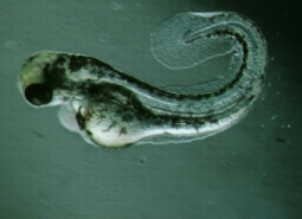|
Dr. Elisabeth Zuber-Knost Kaiserstraße 12 | |
|
In the early stages of development, creatures react rather sensitively to chemical influences. However, so far it has been largely unknown whether and in which doses chemical substances have a toxic effect on developing life. At the KIT Institute of Toxicology and Genetics (ITG), scientists have now developed a model system with fish embryos, whereby the impact of environmental poisons can be detected genetically in a very specific manner and at an early time point. |
For details, please contact: Inge Arnold |
|
For the test, the KIT scientists exposed embryos of the zebra fish to various environmental poisons like dioxin, DDT, cadmium or mercury and analyzed the response of the genome. By this treatment, several hundred genes are activated in the organism. The result is a typical gene pattern that may be read like a genetic bar code. With this method, the evolutionary biologists succeeded in predicting with a high reliability the environmental poison used. “It was very impressive how specific the gene responses were, by means of which 14 of 15 environmental poisons used could be identified”, says the head of the ITG, Professor Uwe Strähle. The effects were already obvious at a concentration that did not yet cause any external changes of the embryos. Hence, the method is more sensitive than today’s conventional biomonitoring tests, in which morphological changes serve as an indication of a toxic effect. “In the future, this system might be used for the prior screening of new substances in order to assess their hazard potential at an early time point”, stresses Strähle. But the method may also be suitable for toxicological tests of chemicals already used in pharmacy and the chemical industry. Since the new EU legislation on chemicals REACH (Registration, Evaluation, and Authorisation of Chemicals) has become effective on June 01, 2007, chemical substances reaching an annual production or import quantity of 1 t at least have to be tested and registered with respect to their effects on health and the environment. For about 2500 to 3000 highly hazardous substances that are carcinogenic and may reduce fertility, an authorization process is required. “Zebra fish embryos can be handled easily and are an ethically acceptable vertebrate model to manage the ten thousands of risk tests required within the framework of reach”, states Uwe Strähle. The model may represent an even more important contribution, as this method may be automated in the medium term and, thus, will be suitable for the rapid testing of a large number of substances. The Karlsruhe Institute of Technology (KIT) represents the merger of the Universität Karlsruhe with the Forschungszentrum Karlsruhe. Altogether, it has 8000 employees and an annual budget of 700 million Euros. The KIT will be an institution of internationally excellent research and teaching in natural and engineering sciences. KIT shall attract the best experts from all over the world, set new standards in teaching and promotion of young scientists, and establish the leading European center in the field of energy research. KIT will assume a leading role in nanosciences worldwide. It is the objective of KIT to be one of the most important cooperation partners of industry. | |
Press Release 12/2008
Genetic Bar Code Exposes Environmental Poisons
KIT Scientists Develop Test System with Fish Embryos

Disturbed development: Environmental poisons have resulted in a distortion of the normally straight body of this fish embryo
(Photo by: Forschungszentrum Karlsruhe)
(Photo by: Forschungszentrum Karlsruhe)
rl, March 25, 2008
Contact:
Christian Könemann
Chief Press Officer
Phone: +49 721 608-41190
Fax: +49 721 608-43658
christian koenemann ∂does-not-exist.kit edu
The photo in the best quality available to us may be requested by
presse ∂does-not-exist.kit edu or phone: +49 721 608-41105.
presse ∂does-not-exist.kit edu or phone: +49 721 608-41105.
